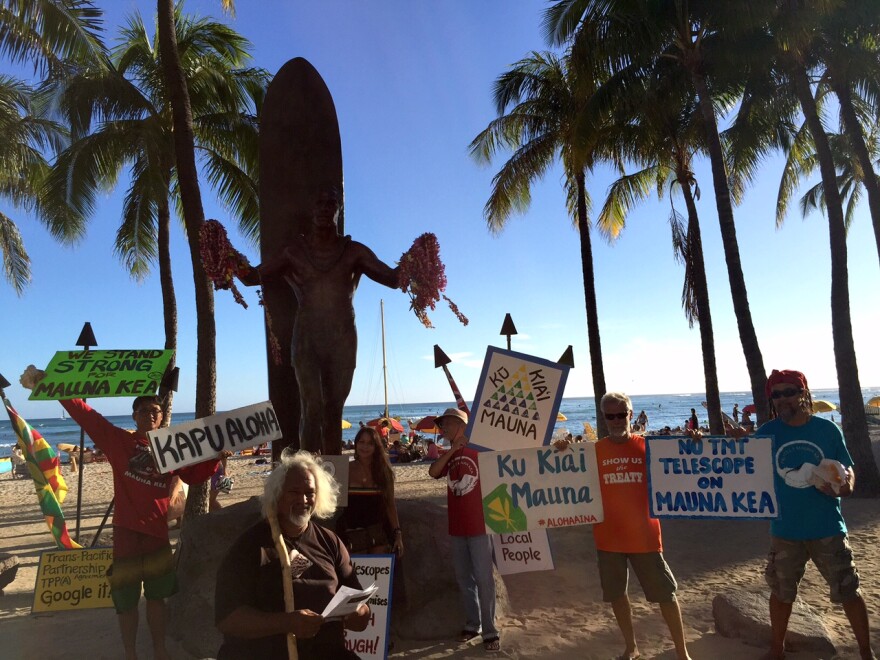Last April, social media buzzed as sign wavings for Mauna Kea “protectors” were held as far away as Kentucky and Tonga. With that first wave of publicity over, the “protectors” both on Mauna Kea and Haleakal? now say there's a guiding principal that keeps them going. HPR’s Noe Tanigawa reports on Kapu Aloha.
The term Kapu Aloha has emerged in varied contexts around recent struggles over Mauna Kea and Haleakal?. An attitude, a code of conduct, a spiritual space, this idea is credited with keeping the demonstrations as civil as they have been when emotions have peaked. Some feel Kapu Aloha is a link with other movements in history and around the world. This is the first of two stories attempting to understand this form of Hawaiian knowledge.
Iokepa Alo is here on Kal?kaua with a handful of others talking with visitors about the thirty Meter Telescope on Mauna Kea, among other things. Their goal, he says, is to share Kapu Aloha internationally.
“What it means is that no matter what happens to us as Hawaiian people, we will stand in love.”
Luana Palapala Busby-Neff, long time Protect Kaho‘olawe ‘Ohana member says, Kapu Aloha was always practiced on that island for safety and out of respect.
“Kapu Aloha for me always begins with a jump into the ocean. Clean out your thoughts and your head, and simple acknowledgment of your place that‘s around you. That connectivity is so important; that deep center and that balance, and that stillness, you draw from that.”
“It’s nothing new, it’s very old.”
Cultural practitioner Pua Case has been practicing Kapu Aloha on Mauna Kea since 1993.
“This is not just about a mauna, Mauna a W?kea. It’s about opening yourself up to be wiser, stronger, connected, and aligned to a purpose. Mauna Kea gives herself as a gift for us to learn, for us to realize that the earth is everything. And I believe that Kapu Aloha is what has drawn the attention to Hawai‘i.”
Busby-Neff says Mauna Kea protesters, or protectors, as they call themselves, need to enter into Kapu Aloha.
“It is through deep compassion and love and commitment for what it is that you are doing that changes everything.”
According to Pua Case, videos of arresting officers dialoguing, even apologizing, show Kapu Aloha at work.
“I believe people all looked this way and said, If they’ll stand there, then we can stand anywhere. Because Hawai‘i will and is contributing to this movement in a very profound way.”
What movement is that?
“The movement of consciousness the movement of awakening. To do something if at all possible without harming any one or any thing, but yet to move forward. And we have to join hands with every other nation around the world that is doing the same. That is the movement.”
“When I sign my letters I say, K? ki‘ai mauna moloko nei. It means, Let our mountains inspire us inwardly. That’s what a Kapu Aloha is.”
That’s scholar-practitioner Manu Aluli Meyer, who proposes Kapu Aloha as a problem solving approach. We’ll take a look at that next.
The Case-Flores ‘ohana shares their mana’o about Mauna Kea
The Case-Flores ‘ohana shares their mana’o about Mauna Kea (4 minute version)
Experience the Spring Equinox up Mauna Kea with the Mamalahoa Chapter of the Royal Order of Kamehameha
Find out more about international nonviolent movements





